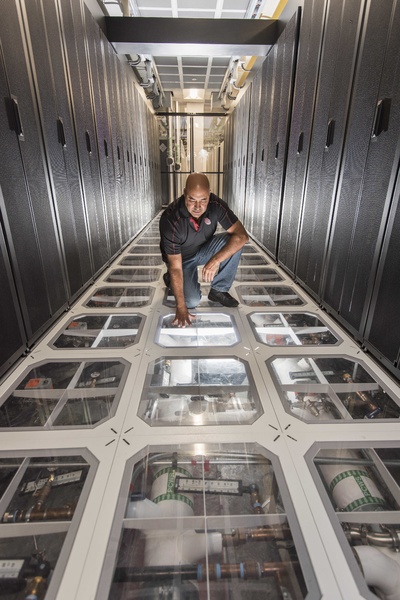|
in the latest issue of nasa tech briefs, sandia national laboratories is highlighted for designing a thermosyphon cooler hybrid system for cooling supercomputers that could save as much as four or five million gallons of water per year in new mexico by avoiding the energy needs of a compressor.

sandia national laboratories engineer david j. martinez examines the cooling
system at sandia’s supercomputing center.
(photo by randy montoya)
the prototype, which was originally announced by sandia in august 2016, uses liquid refrigerant to carry heat away from servers rather than water, which has become a standard procedure for data centers.
according to sandia, “the system works like this: water heated by the computing center is pumped within a closed system into proximity with another system containing refrigerant. the refrigerant absorbs heat from the water so that the water, now cooled, can circulate to cool again.
“meanwhile the heated refrigerant vaporizes and rises in its closed system to exchange heat with the atmosphere. as heat is removed from the refrigerant, it condenses and sinks to absorb more heat, and the cycle repeats.”
instead of using a water tower and cooling by evaporation, which includes a lot of water loss, this system does not require addition chemicals or a compressor. the phase-change refrigerant and outside air are all that is needed, although sandia admits that during the summer months when temperatures outside are regularly above 100°f them water coolers will be required, but infrequently.
the announcement from sandia continued, “for indirect air cooling in a facility, better design brings the correct amount of cooling to the right location, allowing operating temperatures to be raised and allowing the refrigerant cycle to be used more during the year.”
in march, sandia also announced that it is working with three industry partners to commercialize supercritical carbon dioxide (srco2) recopmpression closed brayton cycle technology that could yield thermal-to-electric conversion that is 50 percent greater than conventional steam technology, according to a report on the sandia website.
unlike the standard rankine cycle, which boils pressurized water to create steam, the “s-co2 brayton cycle is that a sensible temperature difference between the hot turbine discharge and the cold compressor discharge drives heat transfer within the cycle, which provides the vast majority of the heat addition to the high-pressure fluid. “
sandia is currently testing a number of components to make this technology commercially viable, including a thermally compliant heat exchanger. the goal is to work with partners to create a 10-megawatt version that can be demonstrated by 2020.
|